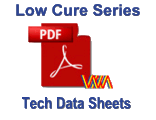
- Direct printing
- White or light colored garments
- 100% Cotton garments
- Cotton/Polyester, Acrylic, Polyester, Polypropylene, Spandex and stretchable substrates
- Superb Bleed Resistance
- No Ghosting
- Great Stretchability
- Easy to print viscosity
- Great replacement for silicone inks
- Flat, smooth finish for multi-color printing
|
Non-Phthalate/PVC Plastisol Inks (LC Inks)
-
- The LC Series is WM’s most versatile series on the market, enabling printers to print on the most difficult substrates. Not only does this system hold up to the worst bleeders, but at the lower cure temps it could save a shop a ton of money in reduced energy costs.
-
- Bleed Resistance: Excellent
-
- Opacity: High
-
- Storage: 70 to 80 F. Due to the ability to cure at low temperatures, this is extremely important. Ink will become thicker over time but can be reduced to a printable viscosity.
-
- Mesh: 61-230
-
- Stencil: Any direct emulsion or capillary film.
-
- Wet on Wet Printing: Can be printed wet-on-wet to increase production.
-
- Modifications: Modifications are not recommended unless completely necessary. To reduce viscosity use Curable Reducer (I10-9906), improve stretch use G&S Base (I10-1020) & puff use Puff Additive (I10-9903). ANY modification will effect Low Cure properties.
-
- Squeegee Hardness & Angle: Medium to hard at a 45 degree angle.
-
- Flashing: 700ºF for 3-5 seconds, just enough for the surface to be tack free.Squeegee Blade: Sharp.
-
- Fusion/Curing: 230º º F/121 C for 1 ½ – 2½ minutes. º º 325 F/163 C for 1 to 1 ½ minutes.
-
- Wash-up: Any plastisol cleaner.
-
- Special Notes: PVC inks are thermoplastic compounds that require heat to fuse or cure. If ink rubs off ona white cloth or cracks, temperature and/or dwell time should be increased. Do not dry clean and alwaystest on fabric to be printed.
Due to the differences in computer monitors and computer video cards, the colors displayed below should be used as a guide only.


